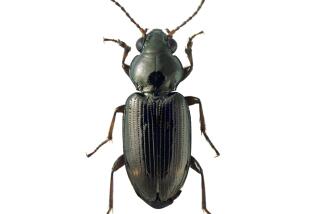Entomologist built career finding, cataloging ants
- Share via
Roy Snelling, an internationally renowned entomologist who turned his boyhood fascination with insects into a lifelong study of the secret world of ants, wasps and bees, has died. He was 73.
Snelling died in his sleep April 21, apparently after suffering a heart attack while in Kenya conducting a field study of rare ants and bees.
The world Snelling dedicated his life to understanding is one that most people know only vaguely, and then only as an annoyance: a buzzing, stinging, crawling menace to picnics and backyard barbecues.
During his 30-year career at the Natural History Museum of Los Angeles County -- the last six as collections manager -- Snelling became a leading expert in all things hymenoptera. He amassed a premier research collection of ants, his specialty.
Where the layperson sees a trail of black ants crawling up a kitchen wall -- wholly unremarkable -- Snelling saw a sliver of a huge, diverse kingdom. Ants are mostly beneficial, but there are ants that destroy crops, ants that damage wood by tunneling and nesting in it, ants that ravage other species of ants.
In Southern California the ant on the wall probably is an Argentine ant, which is not native but has taken up residence and invaded many a home.
For all their abundance, and our proximity to them, “we know very little about the ant,” Snelling said in a 1965 Times article. “Scientists have been studying ants for only 100 years.”
So Snelling traveled the world looking under rocks, setting out chicken scraps as bait and sometimes climbing to the tops of mountains while searching for ant colonies. His studies are the primary reference for the honeypot ants of North America, groups of carpenter ants and the ant life of Chile.
In 1965, when he was 30 and one of only 10 myrmecologists in the world, Snelling followed a hunch and for two years searched for a colony of Nobomessor cockerellis. The shiny, black, slender, termite-eating ant had not been seen in California before. Snelling found the colony on a desert peak 50 miles southwest of Needles and observed it for 44 hours.
Lying on his stomach watching and sometimes listening -- a few species make noises by snapping their jaws or rubbing their legs together -- Snelling understood the lives of ants: how they relate to one another, how they interact with the environment, their social order.
“Big, healthy ants are always females,” he told The Times in 1965. “Straggly, miserable-looking ants are always males. It’s strictly a female’s world. . . . When the act of mating is completed, in a matter of seconds the male drops dead.” A queen ant can live as long as 15 years.
Snelling’s interest in insects began in Turlock, Calif., where he was born Sept. 30, 1934. As a boy he spent his lunch breaks in the fields near his school “out poking around, looking for critters,” said his son, Gordon, who also is an entomologist.
Roy Snelling’s father, who was a farmer, and his mother “thought he was nuts,” Gordon Snelling said. “But he became successful at it and his parents saw it wasn’t a lark.”
After attending community college in Modesto for a year and a half, Snelling dropped out and trained himself. In 1959, after a stint in the Army, he worked with the California Department of Agriculture, inspecting silos, granaries and barns for plant pests and helping eradicate them. He joined the county museum in 1963 and retired in 1993.
Snelling also was an ant taxonomist -- one of a small circle who describe and name new species. He found previously undocumented species and placed them in ant annals.
He described and named many ant species, including Myrmecocystus tenuinodis, the honeypot ant, and Myrmecocystus wheeleri, after a noted myrmecologist. Proud of his Cherokee heritage, Snelling sometimes used Native American references in naming ants.
Snelling’s work in taxonomy is as significant as that of a mapmaker, said Jack Longino, a colleague and professor of entomology at Evergreen State College in Olympia, Wash.
“You’re making a map of the biodiversity of the planet,” Longino said. “You need these maps. You need the names and identifications of these things, to know what these introduced ants are and to be aware of them when they arrive.”
This summer Snelling was scheduled to teach at the Ant Course, a camp for ant biologists, as he has in years past. Instead, entomologists are mourning his loss on blogs. To them he was the generous curmudgeon who enjoyed classical music, the Southwestern desert, Mexican food and knowing the world of insects.
“Off to the big anthill in the sky,” wrote Corrie Moreau on Myrmecos Blog. “The ant community is a better place for your contributions both scientifically and personally.”
In addition to his son Gordon, Snelling, who was married and divorced twice, is survived by another son, Michael Duffy of San Carlos, Calif.; a daughter, Shelley Duffy of Fresno; and a brother, Clarence Snelling of Turlock.
A memorial service will be held at a later date.
--






